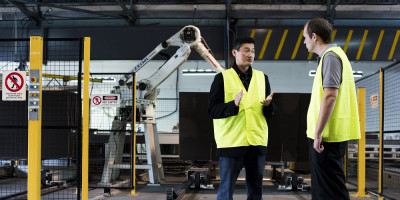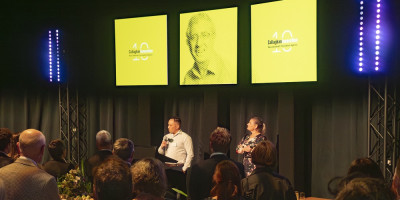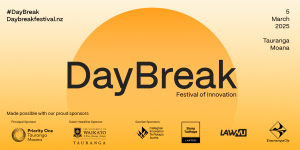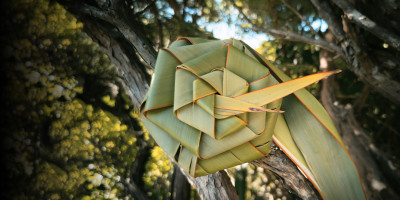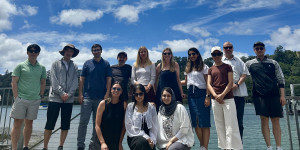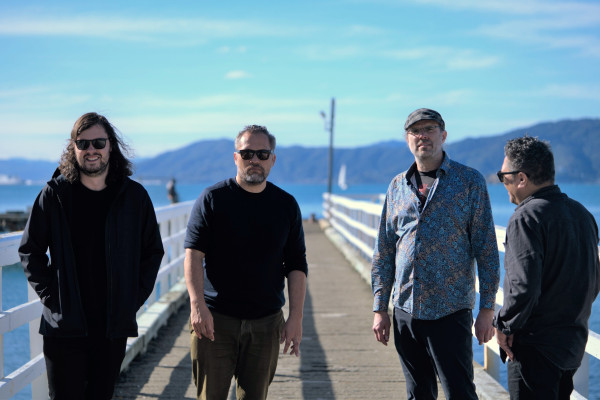An artist and a product design engineer join forces to create award-winning children’s toys through a Māori lens. It’s a kaupapa that has led to Paku being named as one of five finalists in this year’s Kamupene Māori o Te Tau category of this year’s NZ Hi-Tech Awards.
Paku’s story starts at the kōhanga reo sandpit with Wellington designer Johnson Witehira watching his tamariki play.
It occurred to him that all the tools in the sandpit were Western - and that maybe his children would like to play with modern versions of traditional Māori gardening tools. He mentioned his idea to friend and product designer James Prier and the germ of an idea began to grow.
Today that idea is now Witheria (ngāti Hinekura, Ngāi-tū-te-auru) and Prier’s business Paku, a design studio dedicated to creating unique Aotearoa products by combining mātauranga Māori knowledge with the latest technologies to produce objects for use in a contemporary setting.
The partnership started with two gardening tools for children made of fully recycled, engineering-grade nylon. The timo was originally made from the forked branch of a tree while the toki is a two-piece tool used in carving, agriculture and ceremonies.
The development took two years, and the process was underpinned by close consultation with a variety of Māori communities including kōhanga reo, wānanga, Massey University’s School of Māori studies and Tāhuri Whenua Māori food growers’ association. Witehira and Prier asked for feedback, guidance and advice and gradually the project began to feel like a collective initiative.
I was always very passionate about this and very proud of it, but it has always felt like a wider community project
- says Prier
“We wanted to engage people along the way, and every time we had a new idea or a new prototype it was really well received and made you feel like you should do more. At the time we were just trying to find the time around our young families. It was all done at midnight - fortunately we’ve been able to change that over the last six months.”
Now Paku has evolved from being something the pair fitted in around everything else, to something more structured.
“We never really wanted to start it if it didn’t have the potential to go as big as it has. Even though our products may only be a set of digging tools for children, the research and development time that goes into something like this is hundreds and hundreds of hours.”
Prier is now working two to three days a week on the research and development of new products and Witehira - who also runs his own design consultancy - does up to two days when things are busy.
Paku received a huge boost in October at the New Zealand Best Design Awards when the creations won gold in both the Consumer Product and Toitanga categories and then took out the coveted Purple Pin for best product of 2022, with Prier and Witehira feeling like it was confirmation from their industry of their direction and design.

Johnson Witehira and James Prier are the creative forces behind Paku, a company creating toys from a Māori perspective.
They have also spent a lot of time working directly with schools and early childhood centres and tourism shops and attractions. And since tourists started to return to Aotearoa there’s been a steady market for Paku’s products.
But having conquered the sandpit, the pair are now preparing to release new products: “One is definitely aimed at tamariki all the way up to high school, and there’s another that’s more for everyone. And we will be extending our garden products as well.”
The new products will use material that is now considered waste. “I really love the idea of getting something that was going to waste, putting it through a hi-tech process that adds value to it and giving that material new life,” says Prier.
They are also exploring play-based digital technologies: “I know how many new technological design processes went into our current tools, but that technology will be a lot more overt in our new products.”
The awards will be announced in Christchurch on June 23.
Ko te whakahoatanga me te hapori te kaiā i tēnei kamupene o Te Whanganui-a-Tara
Kua tūhono atu tētahi ringatoi ki tētahi kaihoahoa kaipūkaha rauemi ki te waihanga i ēnei takawairore whiringa toa mai i te tirohanga Māori ake nei. Nā tēnei kaupapa hoki kua tohua a Paku hei kaiwhiringa toa mō te rārangi Kamupene Māori o Te Tau mō tēnei tau tonu ki ngā NZ Hi-Tech Awards.
I takea mai te kamupene o Paku, i te puna oneone o te kōhanga reo a ngā tamariki a te kaihoahoa nei o Te Whanganui-a-Tara, ā, Johnson Witehira i a ia e mātakitaki ana i āna tamariki e tākaro ana.
I pupū te whakaaro i roto i a ia nā tana kite i te nuinga o ngā takawairore nō te ao pākehā kē – me tana whakaaro ākene ka rawe ki ana tamariki te tākaro me ngā taputapu a te Māori mō te mahi māra kai. Ka kōrero atu ia ki tana hoa a James Prier, te kaihoahoa, ā, ka toko, ka rea te whakaaro nei.
I tēnei wā kua tū te pakihi a Witehira (Ngāti Hinekura, Ngāi-tū-te-auru) me Prier, arā, a Paku, he taiwhanga hoahoa e waihanga ana i ngā rawa ahurei o Aotearoa, mā te tuitui i te mātauranga Māori me ngā hangarau o nāianei ki te hanga i ngā taputapu hei whakamahi ki tēnei taiao tonu.
I tīmata tēnei kōtuinga me ngā taputapu māra kai e rua mā ngā tamariki i hangaia mai i ngā rawa ngaiaku i hangaruatia. Ko te timo i hangaia mai i te peka rākau tokorera, ā, ko te toki he taputapu wāhanga rua ka whakamahia i roto i ngā mahi whakairo, i ngā mahi ahuwhenua, ngā mahi tikanga Māori hoki.
E rua tau te roa o te tukanga hoahoa, ā, i whānui te toro haere i ngā momo hapori Māori, pēnei i ngā kōhanga reo, i ngā wānanga, i te Kura Māori ki Te Kunenga ki Pūrehuroa me Tāhuri Whenua, he kohinga kaiwhakatipu kai Māori. Ka toro atu a Witehira me Prier mō ētahi urupare, ētahi aratakinga, tohutohu hoki, ā, kātahi ka whai tinana, ka whai kiko te kaupapa whakahirahira nei.
E tino manawanui ana ahau ki tēnei kaupapa, ā, e tika ana me whakahīhī hoki, engari e tika ana kia hou mai te hapori katoa ki tēnei kaupapa,
hei tā Prier.
“Ko tā māua hiahia hoki kia torohia he tangata i a māua e whakaaroaro nei mō tā māua kaupapa, ā, ia te wā ka puta ake he whakaaro hou, he hoahoatanga hou rānei, i ngākaunui mai te hunga tangata, nā tērā, e tika ana kia hangaia mai ētahi atu taputapu. I tērā wā, me whai wā māua ki tēnei mahi i tua atu i te wā e noho tahi ai māua me ā māua whānau. Ko te waenganui pō tonu te wā i mahi ai māua – engari ināianei kua rerekē tērā i roto i ngā marama e ono kua hori nei.”
Nā, kua tipu ake a Paku, mai i te kaupapa mahi noa i te wā e taea ai, ki tētahi pakihi whai tukanga.
“Kāore noa iho māua i hiahia ki te tīmata i te kaupapa nei, ki te kore māua e whakaaro ka whai hua. Ahakoa ko ngā hua i puta he taputapu māra kai noa iho mā ngā tamariki, ko ngā whakaaro, ko ngā mahere, ko ngā rangahau, e hia rau hāora kē.”
I ēnei rā, e mahi ana a Prier mō ngā rangi e rua, e toru rānei mō ngā mahi rangahau me ngā mahi hoahoa o ngā hua hou, ā, ko Witehira – atu i tana pakihi kaihoahoa ake – e rua rā ia e mahi ana, mēnā he wā pukumahi.
I riro mai i te pakihi o Paku tētahi hōnore i te marama o Oketopa, i te kaupapa New Zealand Best Design Awards, ka riro mai te tohu kōura mō ngā wāhanga Consumer Product me te Toitanga, kātahi ka riro mai ko te Pine Waiporoporo mō te hua pai rawa atu mō te tau 2022, ko tā Prier me Witehira, he whakataunaki i tā rāua i whakapono ai mō te kaupapa nei.

Ko Johnson Witehira me James Prier te hunga auaha o Paku, he kamupene waihanga takawairore mai i te tirohanga Māori.
Kua whai wāhi hoki rāua ki te mahi tahi me ngā kura, ngā ratonga kōhungahunga hoki, tae atu ki ngā toa tāpoi, mahinga tāpoi hoki. Nā te hokinga mai o te hunga tāpoi ki Aotearoa nei, rere atu ana ngā hua o Paku ki te ao whānui.
Nā kua whakaekea te āhua ki te puna oneone, e whakarite ana te tokorua nei ki te tuku atu i ngā hua hou: “Ko tētahi ka hāngai ki ngā tamariki tonu, ā, piki noa ki ngā kura tuarua, arā atu anō tētahi ka puta mō te katoa. Ka whakawhānuihia ake e māua ngā taputapu māra kai hoki.”
Ka whakamahia ngā rawa e kīia nei he rāpihi, hei hanga i aua taputapu rā. “He mea whakahirahira ki au te tiki i tētahi mea e kīia nei he rāpihi, kātahi ka hangaruatia mā tētahi tukanga hangarau, e puta ai hei rawa hou, me kī he oranga hou mō taua momo,” hei tā Prier.
E tūhura hoki ana rāua i ngā hangarau matihiko hei hanga mea tākaro: “E mōhio pai ana ahau ki ngā momo tukanga hoahoa hangarau i uru ki ā māua taputapu, ā, ka mārama te kitea o aua momo hangarautanga i roto i ā māua hua hou.”
Ka whakapāohotia ngā hōnore ki Ōtautahi hei te Hune 23.







